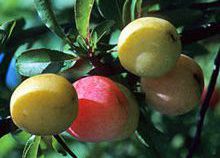
by Carrie Stevenson | Jan 7, 2019
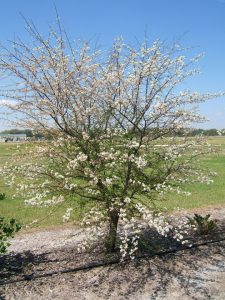
The Chickasaw plum is covered in beautiful small white flowers in the spring. Photo credit: UF IFAS
The native Chickasaw plum is a beautiful smaller tree (12-20 ft mature height) that is perfect for front yards, small areas, and streetscapes. True to its name, the Chickasaw plum was historically an important food source to Native American tribes in the southeast, who cultivated the trees in settlements well before the arrival of Europeans. They typically harvested and then dried the fruit to preserve it. Botanist-explorer William Bartram noted the species during his travels through the southeast in the 1700’s. He rarely saw it in the forests, and hypothesized that it was brought over from west of the Mississippi River.
One of the first trees to bloom each spring, the Chickasaw plum’s white, fragrant flowers and delicious red fruit make it charmingly aesthetic and appealing to humans and wildlife alike. The plums taste great eaten fresh from the tree but can be processed into jelly or wine. Chickasaw plums serve as host plants for the red-spotted purple butterfly, and their fruit make them popular with other wildlife. These trees are fast growers and typically multi-trunked.
Almost any landscape works for the Chickasaw plum, as it can grow in full sun, partial sun, or partial shade, and tolerates a wide variety of soil types. The species is very drought tolerant and performs well in sandy soils.
The plum is in the rose family and has thorns, so it is wise to be aware of these if young children might play near the tree.
Winter is ideal tree-planting time in Florida. While national Arbor Day is in spring, Florida’s Arbor Day is the 3rd Friday of January due to our milder winters. This year, Escambia County’s tree giveaway will include Chickasaw plums, so if this tree sounds like a great addition to your landscape, come visit us on January 19 and pick one up.
For more information about tree selection in northwest Florida, contact your local county Extension office.
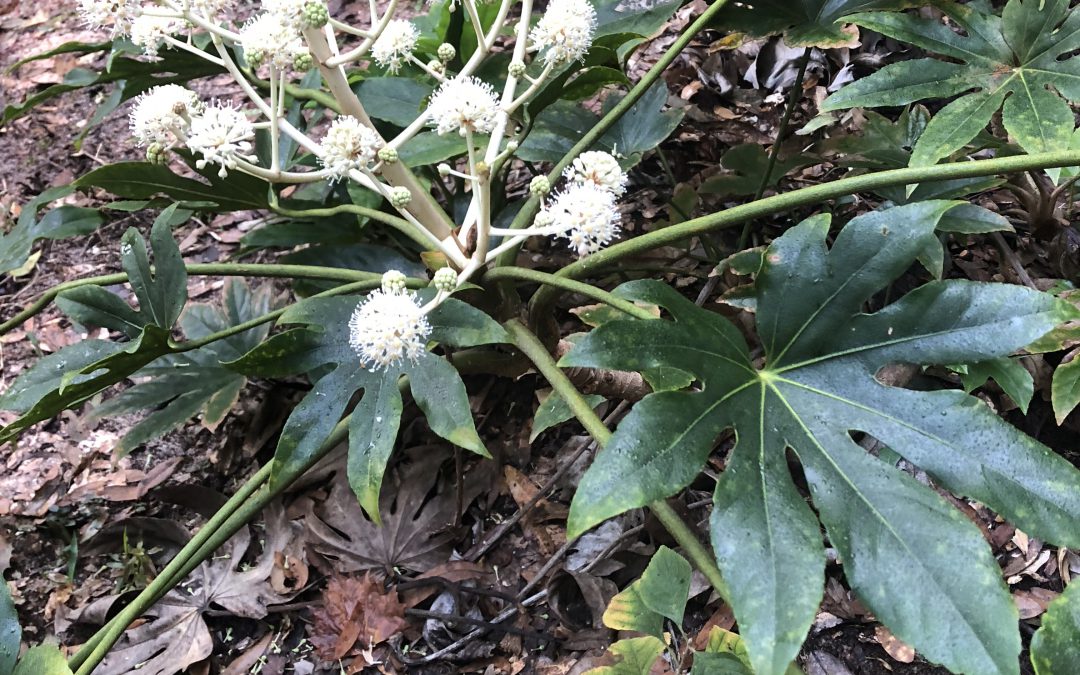
by Matt Lollar | Dec 17, 2018
Fatsia japonica, common name Japanese aralia, provides tropical texture to your landscape. That coarse texture is attributed to its large (nearly a foot wide) leaves that are deeply lobed (maple leaf shaped). This shade-loving plant performs well in moist (not soggy) locations. Upright stems originate near ground level usually near the base of older stems. The stems grow to about eight feet tall before bending toward the ground under their own weight.
Even though the foliage of this species is enough to make you want it in your own garden, you will absolutely fall in love with its blooms. Upright clusters of showy, creamy white flowers begin to appear in fall. These little snowballs provide wonderful color to your garden. The shiny, black fruits appear in winter and are prominent for several weeks. The fruit are know to attract birds to the landscape.
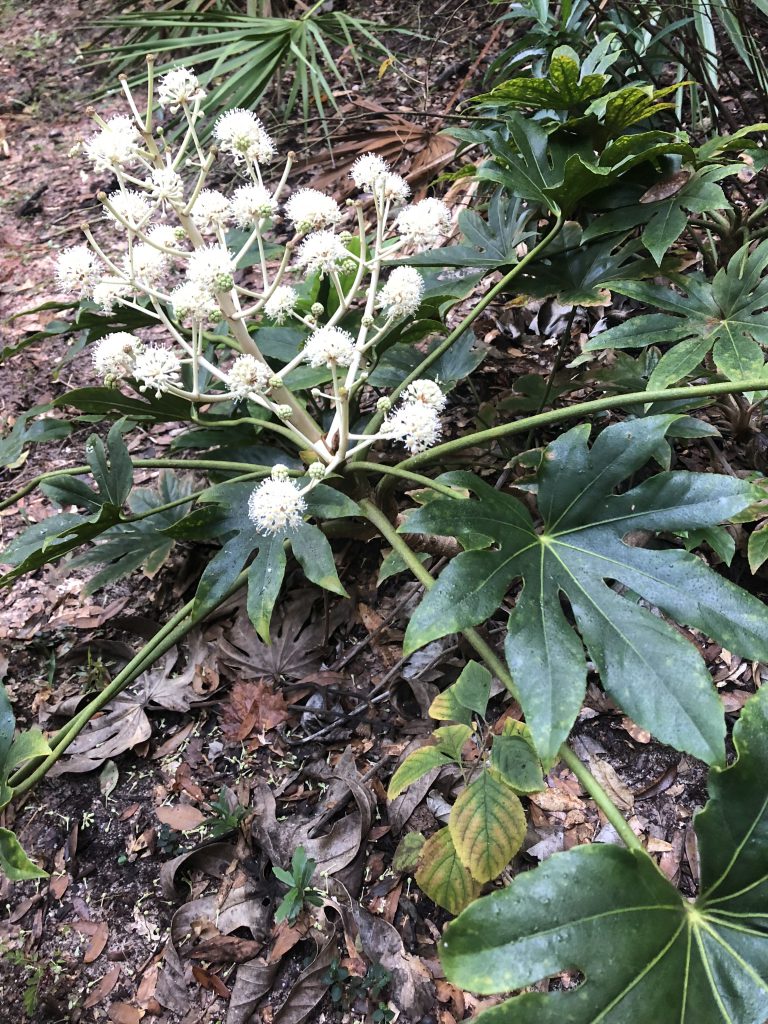
A Fatsia japonica specimen in full bloom. Photo Credit: Matt Lollar, University of Florida/IFAS Extension
Fatsia japonica thrives in the shade in slightly acidic, nutrient-rich, moist soil. Older stems become leggy and can be cut back to encourage branching. In the right place, Fatsia japonica is low-maintenance and not typically bothered by pests. It is also known to perform well in coastal landscapes. It fits well in entryways, in containers, or in mass plantings spaced three feet apart.
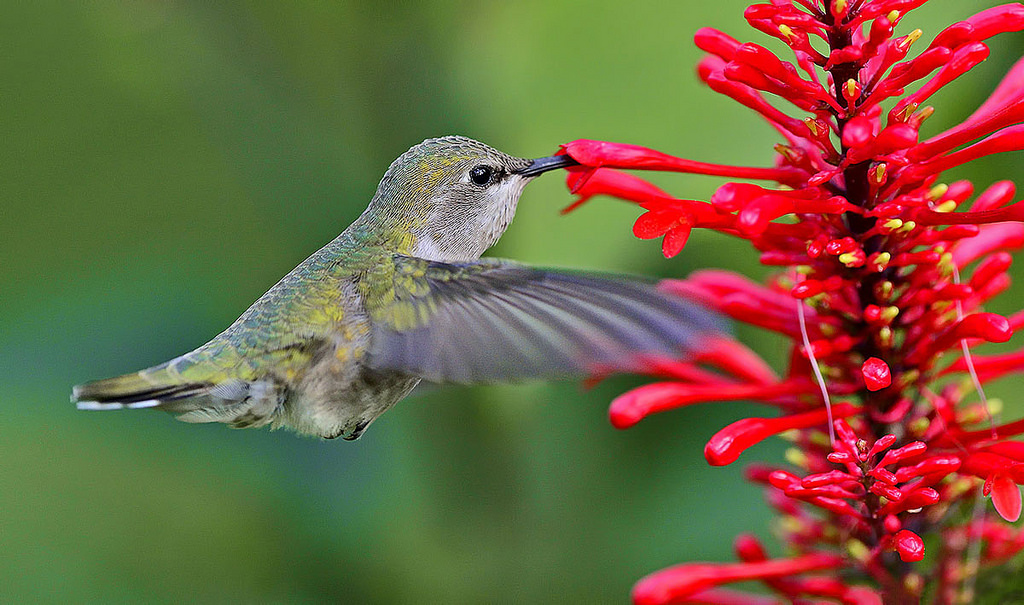
by Sheila Dunning | Nov 8, 2018
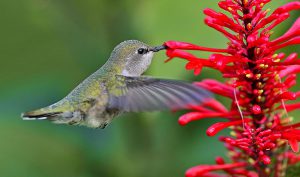 Looking to add something to brighten your landscape this autumn? Firespike (Odontonema strictum) is a prolific fall bloomer with red tubular flowers that are very popular with hummingbirds and butterflies. It’s glossy dark green leaves make an attractive large plant that will grow quite well in dense shade to partial sunlight. In frost-free areas firespike grows as an evergreen semi-woody shrub, spreads by underground sprouts and enlarging to form a thicket. In zones 8 and 9 it usually dies back to the ground in winter and resprouts in spring, producing strikingly beautiful 9-12 inch panicles of crimson flowers beginning at the end of summer and lasting into the winter each year. Firespike is native to open, semi-forested areas of Central America. It has escaped cultivation and become established in disturbed hammocks throughout peninsular Florida, but hasn’t presented an invasive problem. Here in the P
Looking to add something to brighten your landscape this autumn? Firespike (Odontonema strictum) is a prolific fall bloomer with red tubular flowers that are very popular with hummingbirds and butterflies. It’s glossy dark green leaves make an attractive large plant that will grow quite well in dense shade to partial sunlight. In frost-free areas firespike grows as an evergreen semi-woody shrub, spreads by underground sprouts and enlarging to form a thicket. In zones 8 and 9 it usually dies back to the ground in winter and resprouts in spring, producing strikingly beautiful 9-12 inch panicles of crimson flowers beginning at the end of summer and lasting into the winter each year. Firespike is native to open, semi-forested areas of Central America. It has escaped cultivation and become established in disturbed hammocks throughout peninsular Florida, but hasn’t presented an invasive problem. Here in the P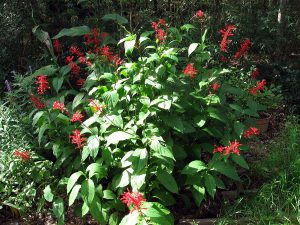 anhandle, firespike will remain a tender perennial for most locations. It can be grown on a wide range of moderately fertile, sandy soils and is quite drought tolerant. Firespike may be best utilized in the landscape in a mass planting. Plants can be spaced about 2 feet apart to fill in the area quickly. It is one of only a few flowering plants that give good, red color in a partially shaded site. The lovely flowers make firespike an excellent candidate for the cutting garden and is a “must-have” for southern butterfly and hummingbird gardens. Additional plants can be propagated from firespike by division or cuttings. However, white-tailed deer love firespike too, and will eat the leaves, so be prepared to fence it off from “Bambi”.
anhandle, firespike will remain a tender perennial for most locations. It can be grown on a wide range of moderately fertile, sandy soils and is quite drought tolerant. Firespike may be best utilized in the landscape in a mass planting. Plants can be spaced about 2 feet apart to fill in the area quickly. It is one of only a few flowering plants that give good, red color in a partially shaded site. The lovely flowers make firespike an excellent candidate for the cutting garden and is a “must-have” for southern butterfly and hummingbird gardens. Additional plants can be propagated from firespike by division or cuttings. However, white-tailed deer love firespike too, and will eat the leaves, so be prepared to fence it off from “Bambi”.
by Sheila Dunning | Dec 14, 2017
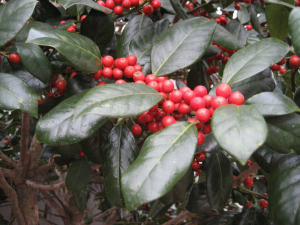 Photo by Sydney Park Brown UF/IFAS
Photo by Sydney Park Brown UF/IFAS
Holly has been considered sacred in some cultures because it remained green and strong with brightly colored red berries no matter how harsh the winter, even when most other plants would wilt and die. According to Druid lore, hanging the plant in homes would bring good luck and protection.
Later, Christians adopted the holly tradition from Druid practices and developed symbolism to reflect Christian beliefs. Today, the red berries are said to represent the blood that Jesus shed on the cross when he was crucified. Additionally, the pointed leaves of the holly symbolize the crown of thorns Jesus wore on his head.
Several holly species are native to Florida. Many more are cultivated varieties commonly used as landscape plants. Hollies (Ilex spp.) are generally low maintenance plants that come in a diversity of sizes, forms and textures, ranging from large trees to dwarf shrubs.
The berries provide a valuable winter food source for migratory birds; however, the berries only form on female plants. Hollies are dioecious plants, with male and female flowers on separate plants. Both male and female hollies produce small white blooms in the spring. Bees are the primary pollinators, carrying pollen from the male hollies 1.5 to 2 miles, so it is not necessary to have a male plant in the same landscape.
Several male hollies are grown for their compact formal shape and interesting new foliage color. Dwarf Yaupon Hollies (Ilex vomitoria ‘Shillings’ and ‘Bordeaux’) form symmetrical spheres without extensive pruning. ‘Bordeaux’ Yaupon has maroon-colored new growth. Neither cultivar has berries.
Hollies prefer to grow in partial shade but will do well in full sun if provided adequate irrigation. Most species prefer well-drained, slightly acidic soils. However, Dahoon holly (Ilex cassine) and Gallberry (Ilex glabra) naturally occur in wetland areas and can be planted on wetter sites.
For a more comprehensive list of holly varieties and their individual growth habits refer to ENH42 Hollies at a Glance: http://edis.ifas.ufl.edu/mg021
by Julie McConnell | May 26, 2017
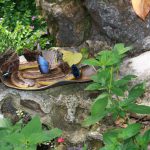
Blue Morpho Butterfly feeding on banana. Photo: J_McConnell, UF/IFAS
Have you been thinking about creating a butterfly garden but don’t know where to start?
Afraid it’s too much upkeep or has to look wild and untamed?
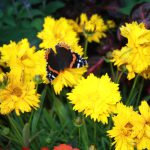
Red Admiral Butterfly. Photo: J_McConnell, UF/IFAS
Spend a Saturday morning with the UF/IFAS Master Gardeners of Bay County to see how to design, install, and maintain a colorful low maintenance butterfly garden.
Next Saturday, June 3rd, is the free Butterfly Gardening Workshop in Panama City at the UF/IFAS Extension Office at 2728 E. 14th Street. Come learn about butterfly gardening and see our vibrant garden.
Please register ahead of time so that we can supply enough materials for all attendees by calling 850-784-6105 or sign up online.
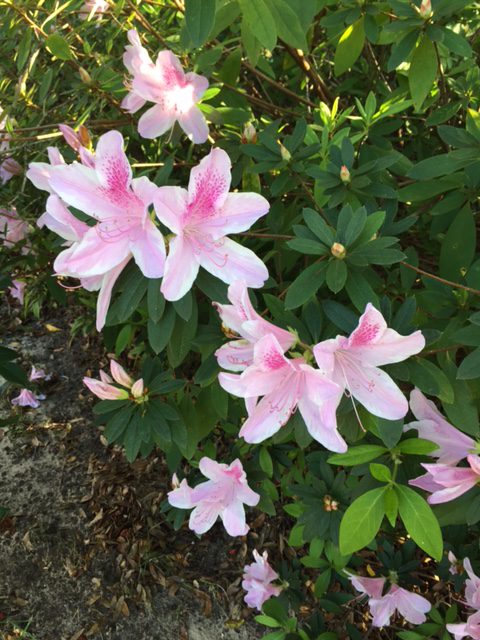
by Carrie Stevenson | Feb 23, 2017
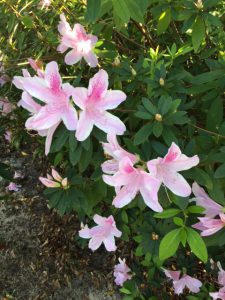
Azaleas have been in full bloom this year since mid-February. Photo credit: Carrie Stevenson
It’s mid-February, and regardless of the groundhog’s prediction, spring seems to have arrived in northwest Florida. In my neighborhood, all the azaleas have bloomed. While beautiful, it’s something that usually doesn’t happen around here until well into March!
According to NOAA and NASA climate data, 2016 was the hottest year globally on record, followed by the previous hottest years, 2015 and 2014. In fact, 16 of the 17 warmest years documented (since official record keeping began in 1880) have been since 2001. The United States also experienced a record-setting year of natural disasters in 2016, ranging from floods to droughts and wildfires.
As the warming trend continues, gardeners, farmers, and wildlife managers alike will find it necessary to adjust their long-held practices. When plants bloom or put on fruit early, these changes can have real economic and commercial impacts. Farmers compete on a global scale to get products to market, and if northern climates start experiencing warmer temperatures, Florida farmers could lose their competitive edge.
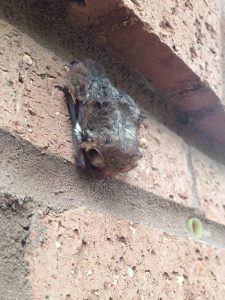
Juvenile bats are vulnerable and therefore protected by state laws during late spring through summer in Florida. Photo credit: Carrie Stevenson
In natural systems, a change in migration or hatching could affect the success of a protected species’ survival. The time frames for these life stages are often legally protected by state or federal laws. For example, in Florida, bats cannot be “excluded” from a building between the April 16-August 14 due to the maternity season. Beach re-nourishment projects are restricted and heavily monitored during sea turtle nesting from May-October. If these time frames start skewing earlier in the year due to changing temperatures and early onset of spring and summer, laws or common practices might need to be evaluated and changed.
In response to these changes in weather patterns, the interesting science of phenology (not to be confused with the brain-mapping “science” of phrenology) has regained popularity in recent years. Phenology is the study of when annual events in the natural world begin—the first hatching of shorebirds, the blooming of spring flowers, the migration of butterflies. For many years, both amateur and professional naturalists have kept records of these phenomena, observing them for pure scientific interest. Now, phenology research has become real-time documentation of a changing world. There are several national networks of citizen scientists making observations and recording them online, including Project Budburst, FrogWatch USA, and the National Phenology Network. If you enjoy spending time outdoors, consider joining one of the many phenology networks and contributing to the larger body of scientific observation. The more we understand about climate-related changes, the better we can prepare and adapt.








 Photo by Sydney Park Brown UF/IFAS
Photo by Sydney Park Brown UF/IFAS



